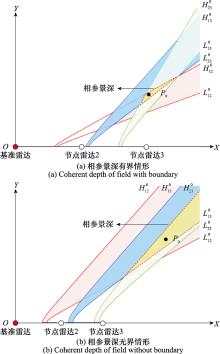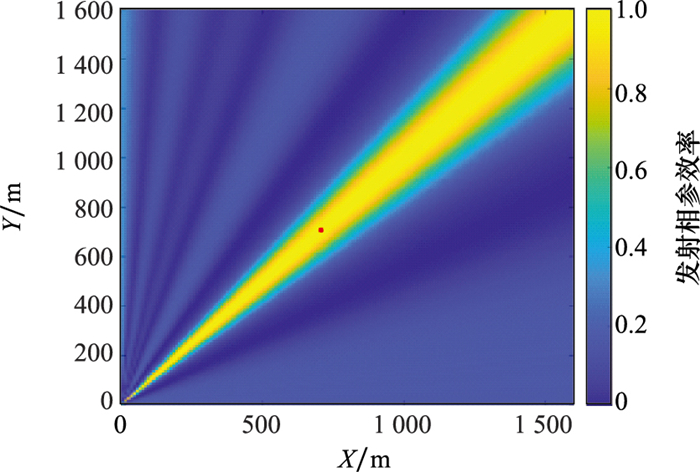| 1 |
CUOMO K M, COUTTS S D, MCHARG J C, et al. Wideband aperture coherence processing for next generation radar(NexGen)[R]. Massachusetts: Lincoln Laboratory, 2004.
|
| 2 |
鲁耀兵, 高红卫. 分布孔径雷达[M]. 北京: 国防工业出版社, 2017.
|
|
LU Y B , GAO H W . Distributed aperture radar[M]. Beijing: National Defense Industry Press, 2017.
|
| 3 |
CHEN J M , WANG T , WU J X , et al. Time and phase synchronization using clutter observations in airborne distributed coherent aperture radars[J]. Chinese Journal of Aeronautics, 2022, 35 (3): 432- 449.
doi: 10.1016/j.cja.2021.08.040
|
| 4 |
陈金铭, 王彤, 吴建新, 等. 基于特显点的机载分布式相参雷达同步误差校正方法[J]. 电子与信息学报, 2021, 43 (2): 356- 363.
|
|
CHEN J M , WANG T , WU J X , et al. Airborne distributed coherent aperture radar synchronization error calibration method based on prominent points[J]. Journal of Electronics & Information Technology, 2021, 43 (2): 356- 363.
|
| 5 |
CHEN J M , WANG T , LIU X Y , et al. Identifiability analysis of positioning and synchronization errors in airborne distributed coherence aperture radars[J]. IEEE Sensors Journal, 2022, 22 (6): 5978- 5993.
doi: 10.1109/JSEN.2022.3144481
|
| 6 |
NANZER J A , SCHMID R L , COMBERIATE T M , et al. Open-loop coherent distributed arrays[J]. IEEE Trans.on Microwave Theory and Techniques, 2017, 65 (5): 1662- 1672.
doi: 10.1109/TMTT.2016.2637899
|
| 7 |
MGHABGHAB S R , ELLISON S M , NANZER J A . Open-loop distributed beamforming using wireless phase and frequency synchronization[J]. IEEE Microwave and Wireless Components Letters, 2022, 32 (3): 234- 237.
doi: 10.1109/LMWC.2021.3122031
|
| 8 |
NANZER J A , MGHABGHAB S R , ELLISON S M , et al. Distributed phased arrays: challenges and recent advances[J]. IEEE Trans.on Microwave Theory and Techniques, 2021, 69 (11): 4893- 4907.
doi: 10.1109/TMTT.2021.3092401
|
| 9 |
MGHABGHAB S R , NANZER J A . Open-loop distributed beamforming using wireless phase and frequency synchronization[J]. IEEE Trans.on Microwave Theory and Techniques, 2022, 32 (3): 234- 237.
|
| 10 |
SUN P L , TANG J , HE Q , et al. Cramer-Rao bound of parameters estimation and coherence performance for next generation radar[J]. IET Radar, Sonar & Navigation, 2013, 7 (5): 553- 567.
|
| 11 |
LIU X H , XU Z H , XIAO S P . Performance gain bounds of coherently combining multiple radars in a target-based calibration manner[J]. Journal of Systems Engineering and Electro-nics, 2019, 30 (2): 278- 287.
doi: 10.21629/JSEE.2019.02.07
|
| 12 |
LIU X H , XU Z H , LIU X , et al. A clean signal reconstruction approach for coherently combining multiple radars[J]. EURASIP Journal on Advances in Signal Processing, 2018, 47.
|
| 13 |
LIU X Y , WANG T , CHEN J M , et al. Efficient configuration calibration using ground auxiliary receivers at inaccurate locations[J]. Digital Signal Processing, 2022, 129, 103675.
doi: 10.1016/j.dsp.2022.103675
|
| 14 |
LIU X Y , WANG T , CHEN J M . Identifiability analysis for configuration calibration in distributed sensor networks[J]. Remote Sensing, 2022, 14 (16): 3920.
doi: 10.3390/rs14163920
|
| 15 |
LIU X Y , WANG T , CHEN J M , et al. Efficient configuration calibration in airborne distributed radar systems[J]. IEEE Trans.on Aerospace and Electronic Systems, 2022, 58 (3): 1799- 1817.
doi: 10.1109/TAES.2021.3139431
|
| 16 |
LIU Y . Structure-based joint estimation algorithm for distributed coherent aperture radar[J]. The Journal of Engineering, 2020, 2020 (11): 1123- 1130.
doi: 10.1049/joe.2019.0907
|
| 17 |
LIU X Y , WANG T , CHEN J M , et al. Joint source localization and sensor position refinement with extra inter-sensor information[J]. IEEE Signal Processing Letters, 2022, 29, 1107- 1111.
doi: 10.1109/LSP.2022.3160863
|
| 18 |
刘兴华, 徐振海, 肖顺平. 分布式相参雷达几何布置约束条件[J]. 系统工程与电子技术, 2017, 39 (8): 1723- 1731.
doi: 10.3969/j.issn.1001-506X.2017.08.09
|
|
LIU X H , XU Z H , XIAO S P . Geometric arrangement constraints of distributed coherent aperture radar[J]. Systems Engineering and Electronics, 2017, 39 (8): 1723- 1731.
doi: 10.3969/j.issn.1001-506X.2017.08.09
|
| 19 |
FANG S T , LI W M , XUE Z H , et al. Synthesis of distributed array consisting of two subarrays via hybrid method of differential evolution optimization and convex optimization[J]. IEEE Antennas and Wireless Propagation Letters, 2021, 20 (2): 125- 129.
doi: 10.1109/LAWP.2020.3035177
|
| 20 |
ELLISON S M, NANZER J A. Comparison of crossover recombination operators in GA-optimized sparse linear array design[C]//Proc. of the IEEE International Symposium on Antennas and Propagation & USNC/URSI National Radio Science Meeting, 2017: 145-146.
|
| 21 |
LIU X H , XU Z H , WANG L , et al. Dual-radar coherently combining: generalized paradigm and verification example[J]. IET Radar, Sonar & Navigation, 2019, 13 (5): 689- 699.
|
| 22 |
周宝亮, 周东明, 高红卫, 等. 分布式孔径相参合成雷达联合天线增益分析[J]. 雷达学报, 2017, 6 (4): 332- 339.
|
|
ZHOU B L , ZHOU D M , GAO H W , et al. Distributed aperture coherence-synthetic radar joint antenna gain analysis[J]. Journal of Radars, 2017, 6 (4): 332- 339.
|
| 23 |
ZENG T , YIN P L , LIU Q H . Wideband distributed coherent aperture radar based on stepped frequency signal: theory and experimental results[J]. IET Radar, Sonar & Navigation, 2016, 10 (4): 672- 688.
|
| 24 |
XIAO X D , LI S Y , PENG S W , et al. Microwave photonic wideband distributed coherent aperture radar with high robustness to time synchronization error[J]. Journal of Lightwave Technology, 2021, 39 (2): 347- 356.
doi: 10.1109/JLT.2020.3030668
|
| 25 |
SHIN D H , JUNG D H , KIM D C , et al. A distributed FMCW radar system based on fiber-optic links for small drone detection[J]. IEEE Trans.on Instrumentation and Measurement, 2017, 66 (2): 340- 347.
doi: 10.1109/TIM.2016.2626038
|
| 26 |
MGHABGHAB S R , SCHLEGEL A , NANZER J A . Adaptive distributed transceiver synchronization over a 90 m microwave wireless link[J]. IEEE Trans.on Antennas and Propagation, 2022, 70 (5): 3688- 3699.
doi: 10.1109/TAP.2021.3138506
|
| 27 |
吴剑旗. 先进米波雷达[M]. 北京: 国防工业出版社, 2015.
|
|
WU J Q . Advanced metric wave radar[M]. Beijing: National Defense Industry Press, 2015.
|
| 28 |
CHATTERJEE P, NANZER J A. Using platform motion for improved spatial filtering in distributed antenna arrays[C]//Proc. of the IEEE Radio and Wireless Symposium, 2018: 253-255.
|
| 29 |
CHEN D , VAKALIS S , NANZER J A . Dynamic antenna array design for scene classification through fourier-domain filtering[J]. IEEE Trans.on Antennas and Propagation, 2021, 69 (9): 5953- 5962.
doi: 10.1109/TAP.2021.3069521
|
| 30 |
臧会凯, 雷欢, 但晓东, 等. 分布式雷达相参发射原理与性能分析[J]. 电子与信息学报, 2015, 37 (8): 1801- 1807.
|
|
ZANG H K , LEI H , DAN X D , et al. Theory and performance analysis of coherent transmission for distributed radars[J]. Journal of Electronics & Information Technology, 2015, 37 (8): 1801- 1807.
|
| 31 |
吴剑旗, 戴晓霖, 杨利民, 等. 一种大基线分布雷达近场相参探测技术[J]. 雷达科学与技术, 2020, 18 (6): 579- 583.
doi: 10.3969/j.issn.1672-2337.2020.06.001
|
|
WU J Q , DAI X L , YANG L M , et al. Study on a near-field coherent detection technology for long-baseline distributed radar[J]. Radar Science and Technology, 2020, 18 (6): 579- 583.
doi: 10.3969/j.issn.1672-2337.2020.06.001
|























